
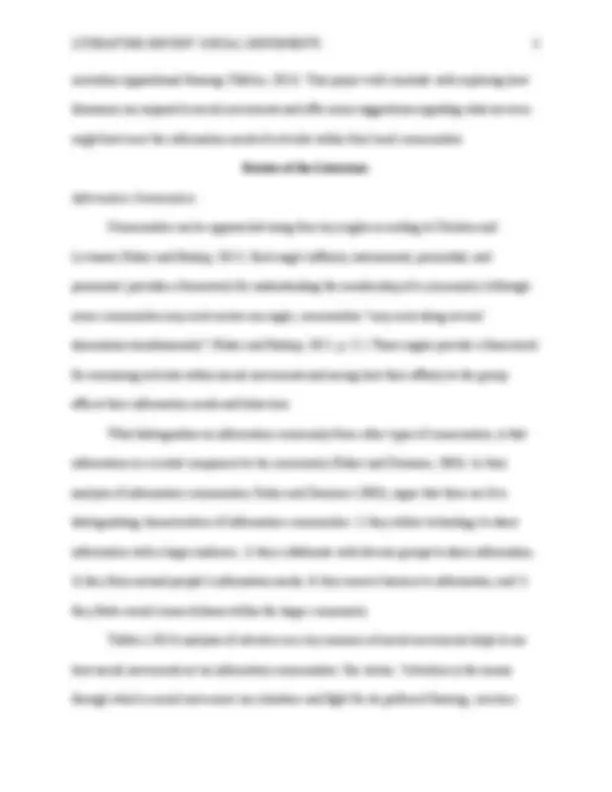
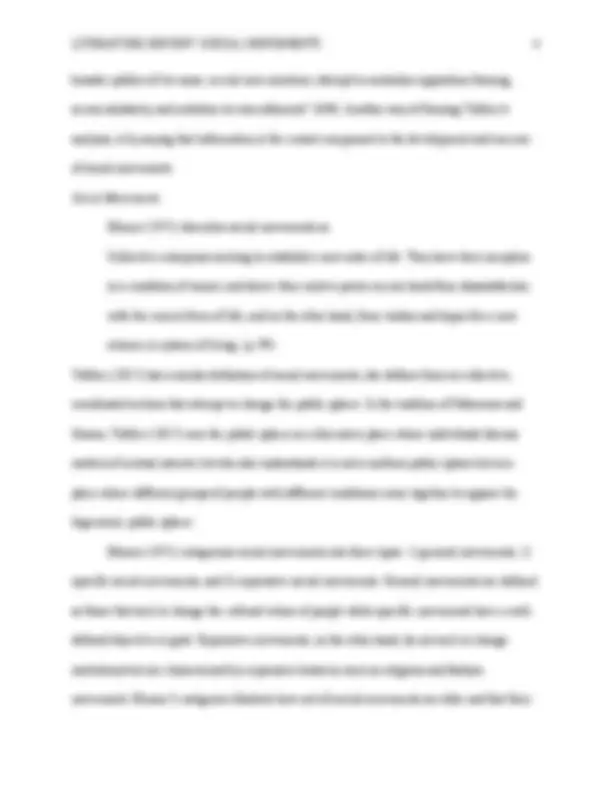
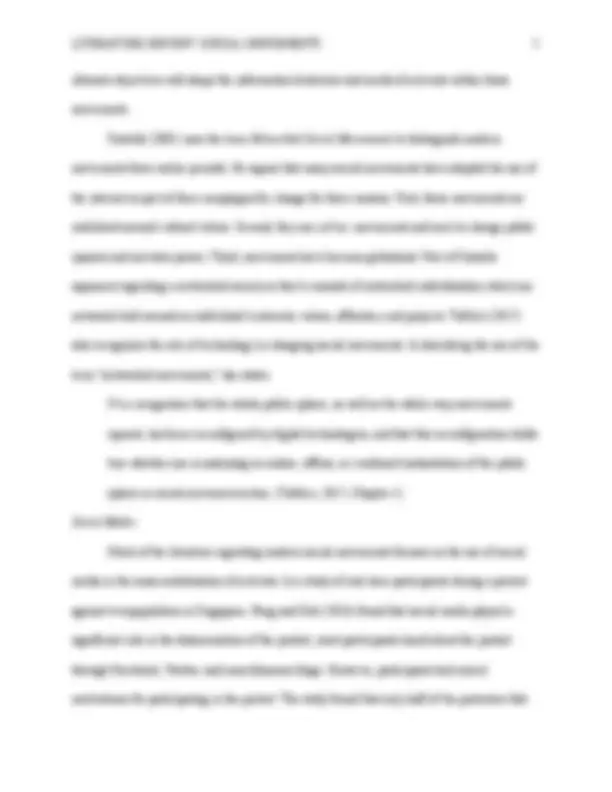
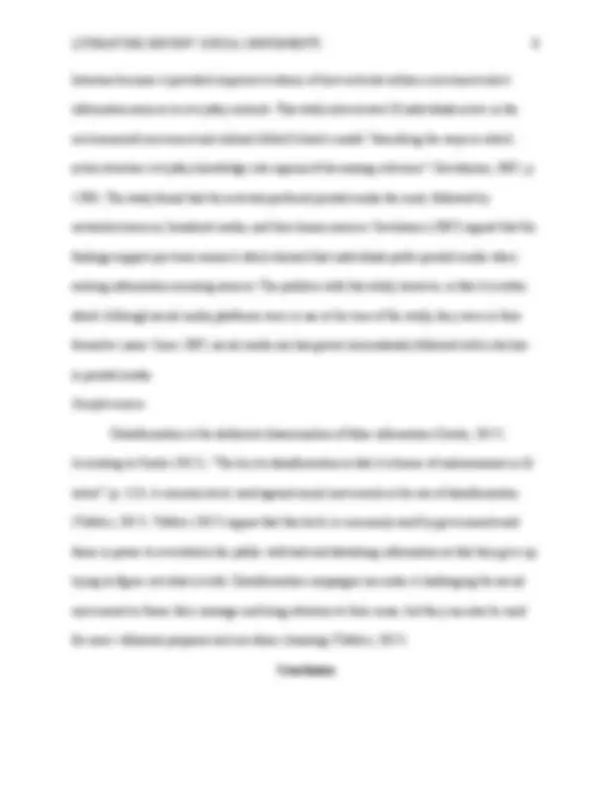
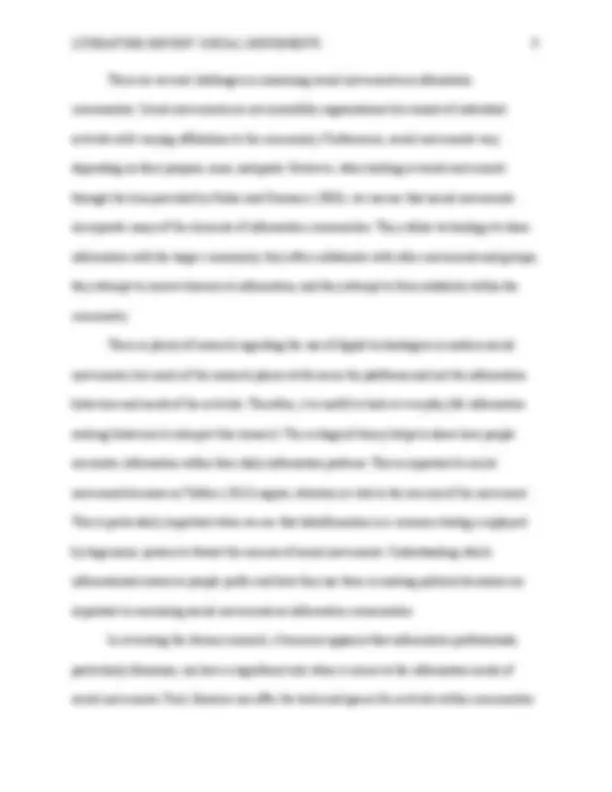



Study with the several resources on Docsity

Earn points by helping other students or get them with a premium plan


Prepare for your exams
Study with the several resources on Docsity

Earn points to download
Earn points by helping other students or get them with a premium plan
Community
Ask the community for help and clear up your study doubts
Discover the best universities in your country according to Docsity users
Free resources
Download our free guides on studying techniques, anxiety management strategies, and thesis advice from Docsity tutors
This literature review explores the relationship between social movements and information communities. It analyzes the information behaviors of activists within social movements, particularly their use of social media, and applies ecological theory to provide a broader understanding of their information needs. The review also discusses the role of disinformation in social movements and suggests ways in which libraries and librarians can support social movements within their communities. a list of references for further reading.
Typology: Exercises
1 / 12

This page cannot be seen from the preview
Don't miss anything!







Literature Review: Information Communities Jason Weekley INFO 200: Stephens San Jose State University Fall 2018
Introduction Social movements are collective, coordinated actions that attempt to change the public sphere (Tufekci, 2017). Although social movements vary greatly regarding their purpose, strategies, and goals, they share one commonality in that they endeavor to change society to reflect their own worldview. Examples of social movements include: the civil rights movement, the labor movement, the peace movement, and the environmental movement to name a few. A recent development in modern social movements is that they are often referred to by their hashtag: #OccupyWallStreet, #BlackLivesMatter, #NODAPL, #MeToo. This practice is reflective of the widespread use of digital technologies, particularly social media, in modern social movements. This project analyzes social movements as information communities and seeks to understand the information behaviors of activists within those communities. The following will explore the literature relating to information communities, social movements, the role of social media in modern social movements, ecological theory, and disinformation. Much of the literature on social movements focuses on the use of social media, particularly Facebook and Twitter, in mobilizing people. This, however is only one aspect of the information behavior of social movements. Therefore, this project seeks to analyze social movements using everyday life information seeking theories, particularly using a framework of ecological theory to provide a broader understanding of the information needs and behaviors of activists within social movements. Approaching social movement through the lens of information seeking reveals how movements seek to mobilize its members, recruit new people, obtain broader public support, and
broader publics of its cause, recruit new members, attempt to neutralize opposition framing, access solidarity, and mobilize its own adherents” (849). Another way of framing Tufekci’s analysis, is by saying that information is the central component to the development and success of social movements. Social Movements Blumer (1971) describes social movements as: Collective enterprises seeking to establish a new order of life. They have their inception in a condition of unrest, and derive their motive power on one hand from dissatisfaction with the current form of life, and on the other hand, from wishes and hopes for a new scheme or system of living. (p. 99) Tufekci (2017) has a similar definition of social movements; she defines them as collective, coordinated actions that attempt to change the public sphere. In the tradition of Habermas and Hauser, Tufekci (2017) sees the public sphere as a discursive place where individuals discuss matters of mutual interest, but she also understands it is not a uniform public sphere but as a place where different groups of people with different conditions come together to oppose the hegemonic public sphere. Blumer (1971) categorizes social movements into three types: 1) general movements, 2) specific social movements, and 3) expressive social movements. General movements are defined as those that seek to change the cultural values of people while specific movements have a well- defined objective or goal. Expressive movements, on the other hand, do not seek to change institutions but are characterized by expressive behavior such as religious and fashion movements. Blumer’s categories illustrate how not all social movements are alike and that their
ultimate objectives will shape the information behaviors and needs of activists within those movements. Castells (2001) uses the term Networked Social Movements to distinguish modern movements from earlier periods. He argues that many social movements have adopted the use of the internet as part of their campaigns for change for three reasons. First, these movements are mobilized around cultural values. Second, they are ad hoc movements and seek to change public opinion and not state power. Third, movements have become globalized. Part of Castells argument regarding a networked society is that it consists of networked individualism which are networks built around an individual’s interests, values, affinities, and projects. Tufekci (2017) also recognizes the role of technology in changing social movements. In describing the use of the term “networked movements,” she states: It’s a recognition that the whole public sphere, as well as the whole way movements operate, has been reconfigured by digital technologies, and that this reconfiguration holds true whether one is analyzing an online, offline, or combined instantiation of the public sphere or social movement action. (Tufekci, 2017, Chapter 1) Social Media Much of the literature regarding modern social movements focuses on the use of social media in the mass mobilization of activists. In a study of real-time participants during a protest against overpopulation in Singapore, Pang and Goh (2016) found that social media played a significant role in the dissemination of the protest; most participants heard about the protest through Facebook, Twitter, and miscellaneous blogs. However, participants had mixed motivations for participating in the protest. The study found that only half of the protesters that
challenges that arise because they often do not have an internal infrastructure to effectively handle collective decision making (Tufekci, 2017). Ecological Theory and ELIS The ecological theory of human information behavior is a model of information seeking that was developed by Kirsty Williamson (2005) and is situated within the everyday life information seekin g (ELIS) field of research. Savolainen (2010) generally defines ELIS as the acquisition of information to be used in daily life or to solve problems outside of professional tasks or study. Although this field of study differentiates work and non-work information behavior, it views activities done within both contexts as being equally important (Savolainen, 2010). The ecological theory is also built on Bates’s (2002) integrated approach to information seeking which takes a holistic view of the human subject as a physical, biological, social, emotional, and spiritual being that acquires the majority of their information by being aware of their social and physical context. The ecological model of human information behavior emphasizes that information is not always purposefully sought after, but often is incidentally acquired (Williamson, 2005). Furthermore, this model considers social and cultural factors that influence information seeking which in turn affects which information sources are trusted and used (Savolainen, 2010). Savolainen (2007) studied how activists in the environmental movement defined their source preferences in the context of seeking orienting information. This study adds to ELIS
literature because it provided empirical evidence of how activists within a movement select information sources in everyday contexts. This study interviewed 20 individuals active in the environmental movement and utilized Alfred Schutz’s model “describing the ways in which actors structure everyday knowledge into regions of decreasing relevance” (Savolainen, 2007, p. 1709). The study found that the activists preferred printed media the most, followed by networked sources, broadcast media, and then human sources. Savolainen (2007) argued that the findings support previous research which showed that individuals prefer printed media when seeking information orienting sources. The problem with this study, however, is that it is rather dated. Although social media platforms were in use at the time of the study, they were in their formative years. Since 2007, social media use has grown tremendously followed with a decline in printed media. Disinformation Disinformation is the deliberate dissemination of false information (Cooke, 2017). According to Cooke (2017), “The key to disinformation is that it is borne of maliciousness or ill intent” (p. 213). A common tactic used against social movements is the use of disinformation (Tufekci, 2017). Tufekci (2017) argues that this tactic is commonly used by governments and those in power to overwhelm the public with bad and disturbing information so that they give up trying to figure out what is truth. Disinformation campaigns can make it challenging for social movements to frame their message and bring attention to their cause, but they can also be used for more villainous purposes such as ethnic cleansing (Tufekci, 2017). Conclusion
to connect. Second, libraries can provide and educate people about informational sources that might be outside of their everyday information sources. Third, librarians can actively engage in countering disinformation that is disseminated to confuse people into being complacent. These are just some ways in which librarians can support social movements within their communities.
References Bates, M. (2002). Toward an integrated model of information seeking and searching. The New review of information behaviour Research, 3, 1-15. Blumer, H. (1971). Collective Behavior. In A. M. Lee (Ed.). Principles of sociology (pp.65-122). New York: Barnes & Noble, Inc. Castells, M. (2001). The internet galaxy: Reflections on the internet, business, and society. Oxford: Oxford University Press. Cooke, N. A. (2017). Posttruth, truthiness, and alternative facts: Information behavior and critical information consumption for a new age. Library quarterly: Information, community, policy, 3, 211-221. Erdelez, S. (1999). Information encountering: It’s more than just bumping into information. Bulletin of the American society for information science 25 (3) Retrieved from http:// libaccess.sjlibrary.org/login?url=http://dx.doi.org/10.1002/bult. Fisher, K. E. and Bishop, A. P. (2015) Information communities: Defining the focus of information service. In S. Hirsh (Ed.), Information services today: an introduction. Retrieved from: Information_Services_Today_An_Introduction_—- _(3_Information_Communities) Fisher, K. E. and Durrance, J. C. (2003). Information communities. In K. Christensen and D. Levinson (Eds.), Encyclopedia of community: From the village to the virtual world. (pp. 658-660). Thousand Oaks: Sage Publications, Inc. Gerbaudo, P. (2012). Tweets and the streets: Social media and contemporary activism. London: Pluto Press